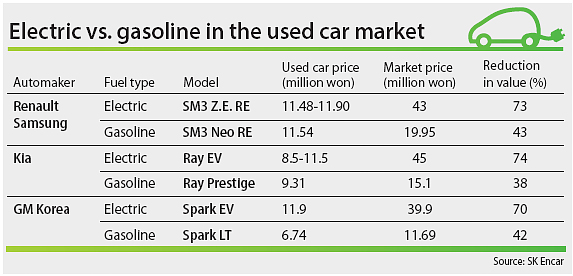Electric cars flounder in the secondhand market

Compared to gasoline-fueled vehicles, electric cars tend to go for less in the secondhand market because of their battery deterioration.
Renault Samsung Motors’ SM3 Z.E. RE electric car, for example, retailed for 43 million won ($38,000) when it was first released in 2014. Now, it goes for 11.5 to 11.8 million won, a 73 percent reduction in value.
On the other hand, its gasoline version, the SM3 Neo RE, has only seen a price drop of 43 percent, from 19.95 million won to 11.5 million won. Although they were essentially the same model manufactured in the same year, their fuel type meant a difference of retrieving two-thirds of the car’s original value versus a fourth.
The situation is similar with cars from other automakers.
Kia Motors’ electric compact car, the Ray EV, retails for 45 million won, but in the secondhand market, it’s worth a mere 8.5 to 11.5 million won.
Meanwhile, its gasoline version, the Ray Prestiage, is being sold for 9.3 million won on used-car sites compared to the new car price of 15.1 million won. That’s a markdown of nearly 40 percent, compared to the 75 percent markdown of the electric version.
“Even if one takes into consideration the subsidy that one receives from the government when buying an electric car, it is being sold at a way lower price in the used car market,” an SK Encar official said.
The official explained that the drastic price reduction comes from natural deterioration in the electric car’s battery. As the vehicle ages, the battery’s capacity, which affects how far the car can travel on one charge, falls accordingly. It is said that about 30 percent of the battery’s capacity is lost after a car is driven for two to three years. The older the car gets, the faster the degradation.
Another problem for electric vehicles in the secondhand market is the pace at which better models are being released. While earlier generations of electric cars could travel just over 100 kilometers (60 miles) on a single charge, newer models can easily surpass 200 and even 300 kilometers per charge.
Jwa Nam-soo, a Democratic Party lawmaker representing Jeju Island, which the government has designated as a testbed for electric cars, released a report in February urging measures to improve the standing of electric cars in the secondhand market.
“Electric vehicles that are purchased with a 40 million won price tag in the first place are being sold at less than 10 million won in the secondhand market,” he said in a report. “Policies for electric vehicle’s treatment in the used-car market are necessary instead of just focusing on how to sell as many as electric cars.”
“Korean consumers are highly sensitive to the resale value of their cars in the secondhand market,” said Kim Pil-soo, an automotive engineering professor at Daelim University.
In Korea, the secondhand market is twice the size of the new-car market, making resale value an important consideration for buyers. According to the Ministry of Land, Infrastructure and Transport, the secondhand market’s size was 3.78 million cars in 2016, up from 3.46 million cars in 2015.
“A separate standard for electric vehicles in the used-car market or measures to replace the battery should be considered to enhance their value and continue to promote their purchases,” Professor Kim said.
BY YOON JUNG-MIN, JIN EUN-SOO [jin.eunsoo@joongang.co.kr]










with the Korea JoongAng Daily
To write comments, please log in to one of the accounts.
Standards Board Policy (0/250자)